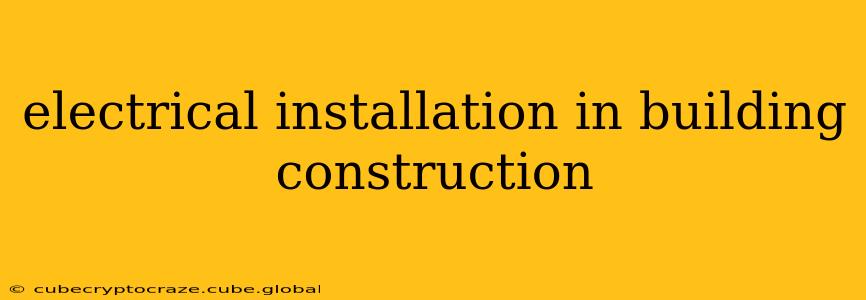Electrical installation is a critical aspect of building construction, ensuring the safe and efficient delivery of power to all building systems and occupants. From initial design to final inspection, this process requires meticulous planning, skilled execution, and strict adherence to safety regulations. This comprehensive guide delves into the key stages and considerations involved in electrical installation within building construction projects.
Planning and Design: The Foundation of Safe Electrical Systems
Before any wiring or equipment installation begins, a thorough planning and design phase is crucial. This involves:
-
Load Calculation: Determining the total power demand of all electrical appliances and systems within the building is paramount. This calculation informs the size and capacity of the required electrical infrastructure, ensuring it can handle the anticipated load without overload or failure. Incorrect load calculations can lead to insufficient power, frequent tripping of circuit breakers, or even fire hazards.
-
Circuit Design: Once the load is calculated, circuits are designed to distribute power efficiently and safely throughout the building. This involves determining the number of circuits, their capacity (amperage), and the location of outlets, switches, and lighting fixtures. Proper circuit design minimizes voltage drop and ensures sufficient power for each area.
-
Code Compliance: Adherence to relevant electrical codes and regulations is non-negotiable. Codes like the National Electrical Code (NEC) in the US or equivalent standards in other regions dictate safety practices, installation methods, and material specifications. Ignoring these codes can result in significant legal and safety repercussions.
-
Schematic Drawings: Detailed schematic drawings are prepared to guide the installation process. These drawings illustrate the layout of wiring, the location of electrical components, and the connections between them. Accurate schematics are vital for efficient and error-free installation.
Installation Process: A Step-by-Step Approach
The actual installation process involves several sequential steps:
-
Wiring: This is the core of the electrical system. Conduit (protective tubing) is installed to route the wiring, providing protection against damage and ensuring code compliance. Various types of wiring exist, each with specific applications and voltage ratings. The selection of appropriate wiring is critical for safety and performance.
-
Outlet and Switch Installation: Outlets and switches are strategically placed throughout the building to provide convenient access to power. Proper grounding and secure connections are essential to prevent electrical shocks and potential fires.
-
Lighting Fixture Installation: Lighting fixtures are installed according to the design plan, ensuring adequate illumination in all areas. Correct fixture selection and installation ensure optimal energy efficiency and safety.
-
Panelboard Installation: The electrical panelboard (breaker box) is the central distribution point for the entire electrical system. It houses circuit breakers that protect circuits from overloads and short circuits. Correct panelboard installation is essential for safe and reliable power distribution.
-
Grounding and Bonding: Grounding provides a path for fault currents to flow safely to the earth, preventing electrical shocks. Bonding connects metal parts within the electrical system to equalize electrical potential, further reducing the risk of shocks.
What are the different types of electrical wiring used in building construction?
Several types of wiring are employed in building construction, each suited for specific applications and voltage requirements. Common types include:
-
Copper Wiring: The most prevalent type, known for its excellent conductivity and durability.
-
Aluminum Wiring: Less commonly used due to its higher risk of overheating and connection problems compared to copper.
-
BX Cable (Armored Cable): A flexible cable with a metallic sheath providing mechanical protection.
-
MC Cable (Metal-Clad Cable): Similar to BX but with improved flexibility and potentially higher ampacity.
-
Romex Cable (Non-metallic Sheathed Cable): A common choice for residential construction, characterized by its ease of installation.
What are the common electrical safety regulations and codes that must be followed during electrical installation?
Electrical safety regulations are crucial for preventing hazards. These regulations vary by location, but common principles include:
-
Proper Grounding: Ensuring all electrical systems are properly grounded to prevent electric shock.
-
Overload Protection: Using circuit breakers or fuses to protect circuits from overloads.
-
Arc Fault Circuit Interrupters (AFCIs): Required in certain locations to detect and interrupt potentially dangerous electrical arcs.
-
Ground Fault Circuit Interrupters (GFCIs): Mandatory in wet areas to prevent electrical shocks.
-
Conduit and Cable Sizing: Using appropriately sized conduit and cables to prevent overheating.
-
Qualified Electricians: Requiring work to be performed by licensed and qualified electricians.
What are the steps involved in grounding and bonding during electrical installation?
Grounding and bonding are crucial for safety:
-
Grounding: Connecting the non-current-carrying metal parts of the electrical system (e.g., metal boxes, conduit) to the earth. This provides a safe path for fault currents to flow to ground, preventing shocks.
-
Bonding: Connecting metallic parts within the electrical system to equalize their electrical potential. This helps prevent voltage differences that could cause hazardous electrical shocks.
Conclusion: Prioritizing Safety and Efficiency
Electrical installation in building construction demands meticulous planning, skilled workmanship, and unwavering adherence to safety regulations. The process, from design to completion, significantly impacts the building’s safety, functionality, and longevity. By following best practices and adhering to relevant codes, building owners and contractors can ensure a safe and efficient electrical system for years to come. Remember, always prioritize safety and engage qualified professionals for all aspects of electrical installation.
